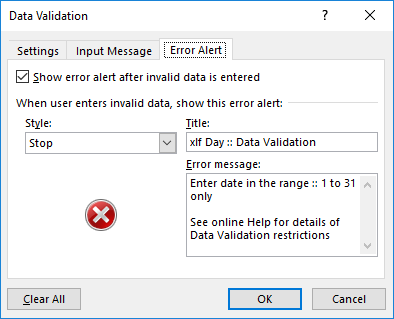MsgBox & Data Validation icons
0. Quick guide
The VBA MsgBox() function allows a choice of an optional icon from a list of four. The icon is displayed to the left of the Prompt.
Icons are part of the Buttons arguments as type VbMsgBoxStyle enumerations with default value 0 (vbOkOnly)
1. The MsgBox() function and VbMsgBoxStyle enumerations
- The MsgBox function Quick Info lists the arguments
- MsgBox(Prompt, [Buttons As VbMsgBoxStyle = vbOKOnly],[Title],[HelpFile],[Context]) As VbMsgBoxResult
- The VbMsgBoxStyle enumerations include four enumerated constants (16, 32, 48 and 64) for icons:
- vbCritical (16)
- vbQuestion (32)
- vbExclamation (48)
- vbInformation (64)
- Icon images are shown in the next section
2. MsgBox enumerated constant icons
Icons are optional. The MsgBox function can display a maximum of one icons from the list.
| Icon | Constant (value) | Description |
|---|---|---|
| |
vbCritical (16) | Displays the Critical Message icon - stop sign |
| |
vbQuestion (32) | Displays the Warning Query icon - a question mark |
| |
vbExclamation (48) | Displays the Warning Message icon - an exclamation point |
| |
vbInformation (64) | Displays the Information Message icon |
The names of the constants are displayed in the VbMsgBoxStyle Quick Info list (figure 1).

3. Data validation Error Alert Style icons
The Excel data validation tool allows the user to compose a custom message box from properties on the Data Validation > Error Alert tab (see figure 2). Three icons are available. The MsgBox vbQuestion icon has been dropped from the list.

| Icon | Style AlertStyle (value) | Description |
|---|---|---|
| |
Stop xlValidAlertStop (1) | Displays the Stop icon |
| |
Warning xlValidAlertWarning (2) | Displays the Warning icon - an exclamation point |
| |
Information xlValidAlertInformation (3) | Displays the Information icon |

The message boxes from MsgBox() function, and the Data Validation Error Alert are compared in figure 3.

Code 1:
xlfDay replicates the Data Validation Error Alert box from figure 2
Sub xlfDay()
Dim Prompt As String, Title As String
Dim Buttons As Integer, Response As Integer, DblLnBreak As String
DblLnBreak = vbNewLine & vbNewLine
Prompt = "Enter date in the range :: 1 to 31 only" & DblLnBreak & _
"See online Help for Details of Data Validation restrictions"
Title = "xlf Day :: MsgBox"
Buttons = VbMsgBoxStyle.vbRetryCancel + _
VbMsgBoxStyle.vbMsgBoxHelpButton + _
VbMsgBoxStyle.vbCritical
Response = MsgBox(Prompt, Buttons, Title) ' Help file, and Context omitted
' Cell value rules not coded
End Sub
Lines 12 to 14 can be written as:
' alternate version of the Button assignment statement without the VbMsgBoxStyle identifier
Buttons = vbRetryCancel + vbMsgBoxHelpButton + vbCritical
Code 2:
xlfDayDV sets Data Validation Error Alert box from figure 2. The Data Validation cell must be the Selection object
Sub xlfDayDV()
Dim Prompt As String, Title As String
Dim Buttons As Integer, Response As Integer, DblLnBreak As String
DblLnBreak = vbNewLine & vbNewLine
Prompt = "Enter date in the range :: 1 to 31 only" & DblLnBreak & _
"See online Help for Details of Data Validation restrictions"
Title = "xlf Day :: Data Validation"
With Selection.Validation
.Delete
.Add Type:=xlValidateWholeNumber, _
AlertStyle:=xlValidAlertStop, _
Operator:=xlBetween, _
Formula1:="1", _
Formula2:="31"
.IgnoreBlank = True
.InCellDropdown = True
.ErrorTitle = Title
.InputMessage = ""
.ErrorMessage = Prompt
End With
End Sub
- Development platform: Excel 2016 (64 bit) Office 365 ProPlus and VBA 7.1
- Published: 3 October 2017
- Revised: Saturday 25th of February 2023 - 10:12 AM, [Australian Eastern Time (AET)]
